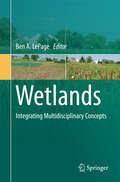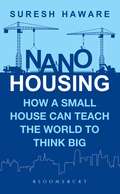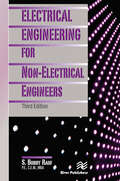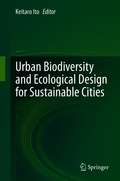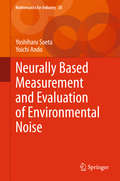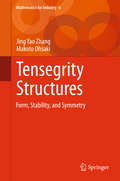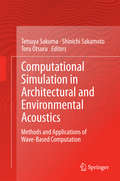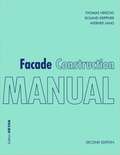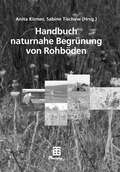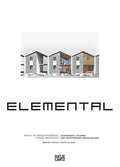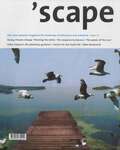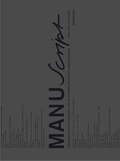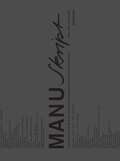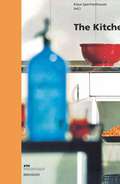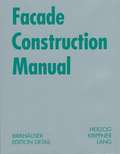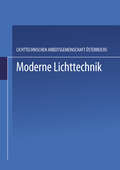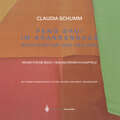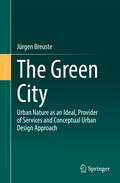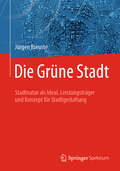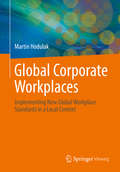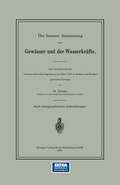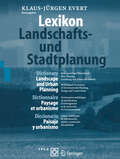- Table View
- List View
Wetlands: Integrating Multidisciplinary Concepts
by Ben A. LePageThe science of wetlands and our understanding of these complex ecosystems have improved considerably. The emergence of multidisciplinary strategies is providing new opportunities and innovative approaches to address issues such as climate change and coastal protection. This book, with contributions from 19 specialists from academia, government, and industry, provides a trans-disciplinary approach to the understanding wetlands science, drawing together a wide range of expertise. Topics covered include the physical aspects that shape different wetlands around the world, as well as wetlands ecology, regulation, policy, and related social and economic issues.Featuring contributions from some of the world’s leading wetlands researchers and practitioners, this book provides an invaluable resource for undergraduate and post-graduate training in all aspects of wetlands management, conservation, and construction. It is also a useful auxiliary text for researchers working across disciplines in fields such as wetlands science, law, landscape architecture, environmental engineering, conservation ecology, and related disciplines.
Nano Housing: How a Small House Can Teach the World to Think BIG
by Suresh HawareThink big, act small… Act now… Many of us think big but fail to micro plan. Others get stuck at micro-planning, missing the 'big picture' of what impacts us nationally and globally. Housing is a basic necessity of human beings across the globe, and not just in India. Affordable housing for the masses is a key challenge for governments and policy makers. In Nano Housing, Dr Suresh Haware brings out a detailed study and offers solutions for the housing needs of India and its states and cities. A path-breaking and time-tested concept, nano housing is the outcome of an in-depth practical research which has the potential to fulfill the dream of the common man-an affordable house at an affordable price. Further, the book addresses the impact of GST, RERA and demonetisation on real estate; analyses REIT, home finance and rental housing; and voices the concern of homeless people, unauthorised housing, redevelopment and many other aspects of housing. An innovative and revolutionary idea, Nano Housing is a must-read for all businessmen in general and professionals, economists, sociologists, officials and policy makers engaged in the housing industry in particular.
Ecology, Cognition and Landscape: Linking Natural and Social Systems (Landscape Series #11)
by Almo FarinaIt is more and more evident that our living system is completely disturbed by human intrusion. Such intrusion affects the functioning of entire systems in ways we do not yet fully understand. We use paradigms such as the disturbance to cover large and deep gaps in our scienti?c knowledge. Human ecology is an uncertain terrain for anthropologists, geographers, and ecologists and rarely is expanded to include the social and economic realms. The integration of different disciplines and the application of their many paradigms to problems of environmental complexity remains a distant goal despite the many efforts that have been made to achieve it. Philosophical and semantic barriers are erected when such integration is pursued by pioneering scientists. Recently, evolutionary ecology has shown great interest in the spatial processes well described by the emerging discipline of landscape ecology. But this interest takes the form of pure curiosity or at worst, of skepticism toward the real capacity of landscape ecology to contribute to the advancement of ecological science. The past two centuries have been characterized by huge changes occurring in the entire ecosphere. Global changes are the effects of human intervention at a planetary scale, with consequent degradation of the environment creating an e- logical debt for future generations. On the other side of the issue, new technologies have improved the welfare of billions of people and have given hope to many other billions that they may also see such improvement in the near future.
Electrical Engineering for Non-Electrical Engineers
by S. Bobby RaufEngineers and non-engineers often eschew electrical engineering because it is premised on concepts and mathematical techniques that are somewhat more abstract and elusive than those employed in disciplines like civil, mechanical, and industrial engineering. Yet, because of the ubiquitous nature of electrical and electronic equipment and devices, and the indispensable role electricity plays in various facets of lives, a basic understanding of electrical engineering is essential. Engineers and non-engineers find themselves interfacing with electrical apparatus and dealing with matters that permeate into the electrical realm. Therein lies the purpose and objective of this book. This edition includes numerous updated pictures, diagrams, tables, charts, graphs, and improved explanation of certain concepts.
Urban Biodiversity and Ecological Design for Sustainable Cities
by Keitaro ItoThis book highlights various designs for urban green spaces and their functions. It provides an interesting meeting point between Asian, European and North America specialists (researchers, planners, landscape architects) studying urban biodiversity; urban biodiversity and green space; relations between people and biodiversity. The most important feature of this book is the unique point of view from each contributor towards “the relationship between nature and people in urban areas”, in the context of the ecosystem and biodiversity in urban areas and how to manage them. All chapters explore and consider the relationship between humans and nature in cities, a subject which is taking on increasing importance as new cities are conceptualized and planned. These discussion and examples would be useful for urban ecology researchers, biologists, city planners, government staff working in city planning, architects, landscape architects, and university instructors. This book can also be used as a textbook for undergraduate and postgraduate city planning, architecture or landscape architecture courses.
Neurally Based Measurement and Evaluation of Environmental Noise (Mathematics for Industry #20)
by Yoshiharu Soeta Yoichi AndoThis book deals with methods of measurement and evaluation of environmental noise based on an auditory neural and brain-oriented model. The model consists of the autocorrelation function (ACF) and the interaural cross-correlation function (IACF) mechanisms for signals arriving at the two ear entrances. Even when the sound pressure level of a noise is only about 35 dBA, people may feel annoyed due to the aspects of sound quality. These aspects can be formulated by the factors extracted from the ACF and IACF. Several examples of measuring environmental noise—from outdoor noise such as that of aircraft, traffic, and trains, and indoor noise such as caused by floor impact, toilets, and air-conditioning—are demonstrated. According to the noise measurement and evaluation, applications for sound design are discussed. This book provides an excellent resource for students, researchers, and practitioners in a wide range of fields, such as the automotive, railway, and electronics industries, and soundscape, architecture, and acoustics.
Tensegrity Structures: Form, Stability, and Symmetry (Mathematics for Industry #6)
by Jing Yao Zhang Makoto OhsakiTo facilitate a deeper understanding of tensegrity structures, this book focuses on their two key design problems: self-equilibrium analysis and stability investigation. In particular, high symmetry properties of the structures are extensively utilized. Conditions for self-equilibrium as well as super-stability of tensegrity structures are presented in detail. An analytical method and an efficient numerical method are given for self-equilibrium analysis of tensegrity structures: the analytical method deals with symmetric structures and the numerical method guarantees super-stability. Utilizing group representation theory, the text further provides analytical super-stability conditions for the structures that are of dihedral as well as tetrahedral symmetry. This book not only serves as a reference for engineers and scientists but is also a useful source for upper-level undergraduate and graduate students. Keeping this objective in mind, the presentation of the book is self-contained and detailed, with an abundance of figures and examples.
Computational Simulation in Architectural and Environmental Acoustics: Methods and Applications of Wave-Based Computation
by Tetsuya Sakuma Shinichi Sakamoto Toru OtsuruThis book reviews a variety of methods for wave-based acoustic simulation and recent applications to architectural and environmental acoustic problems.Following an introduction providing an overview of computational simulation of sound environment, the book is in two parts: four chapters on methods and four chapters on applications. The first part explains the fundamentals and advanced techniques for three popular methods, namely, the finite-difference time-domain method, the finite element method, and the boundary element method, as well as alternative time-domain methods. The second part demonstrates various applications to room acoustics simulation, noise propagation simulation, acoustic property simulation for building components, and auralization.This book is a valuable reference that covers the state of the art in computational simulation for architectural and environmental acoustics.
Facade Construction Manual: (pdf) (Detail Construction Manuals Ser.)
by Thomas Herzog Roland Krippner Werner LangThe facade in the 21st century In recent years, facades have become more important in architectural practice and in public perception. As well as functioning as a protective shell and visible 'face' and supplying heat and electricity, a building's exterior interacts directly with the surrounding public space. This revised and expanded new edition of the Facade Construction Manual offers readers technical and design planning fundamentals in a compact reference work. A section describing a comprehensive selection of built structures shows general and unique, tried and tested, and innovative approaches to facade planning – down to the last detail. Over 100 examples of built structures Material-specific approaches for use in planning facades Technical planning fundamentals Special issues involving modern facade concepts
Handbuch naturnahe Begrünung von Rohböden
by Anita Kirmer Sabine TischewEingriffe in Natur und Landschaft (z. B. Baumaßnahmen, Rohstoffgewinnung, Straßenbau) führen einerseits zu einer nachhaltigen Devastierung von Flächen, die nach Beendigung der Bau- bzw. Abbautätigkeiten wieder in die Landschaft eingegliedert werden müssen, andererseits müssen im Rahmen von Ausgleichs- und Ersatzmaßnahmen naturschutzfachlich wertvolle Flächen geschaffen oder wiederhergestellt werden. In vielen Bereich (z. B. Böschungen) steht dabei Erosionsschutz an erster Stelle. Die in diesem Buch vorgestellten Methoden ermöglichen darüber hinaus eine nachhaltige und standortgerechte Vegetationsentwicklung mit gebietsheimischen Arten. Zum Einsatz kommen dabei ansaatlose Verfahren wie Oberboden- und Mähgutauftrag sowie Mulchdecksaaten mit gebietsheimischem Saatgut. Das Buch ist nach verschiedenen Standortverhältnissen gegliedert, für die geeignete Methoden genau erläutert sowie Beispiele für die jeweiligen Zielzustände gezeigt werden. Der künftige Anwender erhält damit ein übersichtliches Handbuch mit Handlungsanweisungen für unterschiedliche Standorte. Die Angaben basieren dabei auf den neuesten wissenschaftlichen Erkenntnissen (u. a. SURE-Projekt).
Elemental
by Alejandro Aravena Andrés IacobelliWhat began as an academic initiative to improve the quality of life of poor strata of the population has meanwhile become a professional “do tank” offering services that cover the entire spectrum of urban development. Alejandro Aravena (*1967 in Santiago de Chile) founded Elemental in 2001 in his hometown with the goal of alleviating social deprivation directly instead of hoping for a balance of income relations. Besides building public facilities and public housing, Elemental also develops new approaches for the reorganization of resources and the potential of cities by means of projects devoted to infrastructure and transportation. This publication documents the social activity and history of the international architectural team and sheds light on its financing strategies, for example through participative building. 15th International Architecture Exhibition, Venice, May 28–November 27, 2016
Elemental: Incremental Housing and Participatory Design Manual
by Alejandro Aravena Andrés IacobelliWhat began as an academic initiative to improve the quality of life of the poor strata of the population has now become a professional “do tank” offering services that cover the entire spectrum of urban development. The celebrated Chilean architect, winner of the 2016 Pritzker Prize and Director of the 2016 Venice Architecture Biennale, Alejandro Aravena (born 1967) founded Elemental in 2001 in his hometown with the goal of alleviating social deprivation directly instead of hoping for a balance of income relations. Besides building public facilities and public housing, Elemental also develops new approaches for the reorganization of resources and the potential of cities by means of projects devoted to infrastructure and transportation. This volume, first published in 2013 and now back in print, documents the social activity and history of the international architectural team and sheds light on its financing strategies, for example through participatory building.
'scape: The International Magazine of Landscape Architecture and Urbanism (Scape #2/07)
The planning parameters of city planning and landscape architecture are changing as a result of global warming. 'scape 4 presents the most intelligent and exciting designs, and discusses the various possibilities planners have, for working with the changing climate. Designing without water: heat and dryness demand new visions; resource scarcity calls for rethinking. Delta regions are the most densely populated areas in the world. Precisely in these regions the water is rising. In the Netherlands a number of studies and initiatives are investigating what solutions are possible and desirable. Arctic cities are no longer remote, whether economically or in terms of culture or climate. What were once extreme situations can be sensibly developed today. Portrait: The French landscape architect Gilles Clément’s concept of the “jardin planétaire” calls on designers to relate to the earth as a garden. A plea for collective responsibility, poetic and convincing.
Manuscript: Essentials for the Everyday Use of Interior Architects and Designers
by Axel Müller-SchöllThis book provides essential introductory information for designers and interior designers. From the realm of interior design, for example, it deals with ceilings, floors, doors, windows, stairs, etc. – from that of material science, with carpets, wallpaper, wall paint, glass, wood materials, stone, and concrete. It also presents architectural drawing: techniques of representation, descriptive geometry, technical drawing, standard dimensions, signs and symbols, and mathematical foundations; attention is also given to the fundamentals of graphic design, preparing documents for publication, file formats, and color systems. All of this is generously leavened with practical examples; original essays by Ruedi Baur, Axel Kufus, Norbert Rademacher, Martin Kunz, and others; and thought-provoking quotations. If they want to, readers may separate the pages of the Japanese binding – this way they get room to add their personal notes and comments.
Manuskript: Essentials für den Alltag von Innenarchitekten und Designern
by Axel Müller-SchöllDas Buch bietet grundlegende erste Informationen für Innenarchitekten und Designer. Aus den Gebieten der Innenraumgestaltung zu Decken, Fußböden, Wänden, Türen, Fenstern, Treppen etc. Aus der Materialkunde: zu Teppichen, Tapeten, Wandanstrichen, Glas, Holzwerkstoffe, Stein, Beton. Ein weiterer Schwerpunkt ist dem Entwerfen und Aufzeichnen gewidmet: Darstellungstechniken, darstellende Geometrie, technische Zeichnungen, Orientierungsmaße, Zeichen und Symbole und mathematische Grundlagen; hinzu kommen grafische Grundbegriffe, Elemente der Druckvorstufe, Dateiformate und Farbsysteme. Ergänzt und veranschaulicht werden die Informationen mit Praxisbeispielen, originalen Textbeiträgen von Ruedi Baur, Axel Kufus, Norbert Rademacher, Martin Kunz u.a. sowie anregenden Zitaten. Falls der Leser, die Nutzerin des Buches wollen, können die Seiten in Japanbindung aufgetrennt werden: es entsteht so immer wieder Raum für persönlichen Ergänzungen und Notizen.
The Kitchen: Life World, Usage, Perspectives (Living Concepts #1)
by Klaus SpechtenhauserDwelling is more popular than ever. Whether in exhibits, scholarly studies, trend-conscious lifestyle magazines, or easily consumable coffee-table books, the complex factors informing humanity’s c- dition in its lived environment have become the object of diverse and increasingly intense investigations. The new book series Living Concepts intervenes at the juncture of aseptic coffee-table book and academic publication. Selected topics from the field of dwelling are presented with concision and scholarly rigor and in an appealing format. Along with supplying an informative foundation for a given thematic, Living Concepts int- duces current trends, scrutinizes received notions, and hopes to provide impetus for future developments – and all of this once or twice yearly in both German and English. Living Concepts is published by the ETH Wohnforum, an interdisciplinary research group housed in the Faculty of Archit- ture of the Swiss Federal Institute of Technology (ETH) in Zurich. By investigating the interplay and tensions between humans, society, and built space, the group mediates between theory and practice. With Living Concepts, the ETH Wohnforum aims to set a course informed by cultural studies, to document insights provided by the social sciences, and to provide a platform for a critical coming-- terms with the side effects of modernity. It is no accident that this first volume is dedicated to the kitchen.
Die Küche: Lebenswelt, Nutzung, Perspektiven (Living Concepts #1)
by Klaus SpechtenhauserDas Buch erschließt den Lesern die Küche als zentralen Wohnraum des häuslichen Lebens. Die Autorinnen und Autoren untersuchen die Küche – nachdem sie seit den 90er Jahren als modisch-repräsentatives Designobjekt ins Zentrum rückte – in Bezug auf ihre architektonischen, kulturellen, sozialen sowie ökonomischen Bedeutungen. Vorgestellt werden wichtige Entwicklungstendenzen und wegweisende Küchenkonzepte der letzten Jahrzehnte (Frankfurter Küche, Normküchen, Wohnküchen), planerische Grundlagen, aktuellste Trends, die sich wandelnden Bedürfnisse heutiger Benutzer an den Küchenraum (Patchworkfamilien, Singlehaushalte) sowie kulinarische Aspekte. Kurz: Ein Buch, das in keiner Küche des 21. Jahrhunderts fehlen sollte! Unsere neue Buchreihe Edition Wohnen stellt ausgewählte Themen aus dem weiten Feld des Wohnens kurz und übersichtlich vor. Sie richtet sich sowohl an allgemein kulturinteressierte Leserinnen und Leser als auch an Fachleute. Die Reihe wird herausgegeben vom ETH Wohnforum Zürich.
Facade Construction Manual (PDF)
by Thomas Herzog Roland Krippner Werner LangFacades - they are the first feature of a building to be noticed, they determine its distinctive appearance and are often the subject of controversial debate. This new first edition of the Facade Construction Manual provides a systematic survey of contemporary expertise in the application of new materials and energy- efficient technologies in facade design, and represents an invaluable addition to our series of Construction Manuals. It surveys the facade design requirements made by various types of buildings, as well as the most important materials, from natural stone through to synthetics, and documents a diversity of construction forms for a wide range of building types. Over 100 international case-studies in large-scale, detailed drawings are presented in the comprehensive project section.
Feng Shui im Krankenhaus: Architektur und Heilung
by Claudia Schummn den letzten Jahren hat die traditionelle chinesische Lehre von Feng In the last few years, the traditional Chinese philosophy known as feng I Shui eine rasante Entwicklung genom men. Vor sieben Jahren noch shui has seen a massive boom. Just seven years ago, feng shui was vollig unbekannt ist es fOr viele Menschen heute Oblich, Wohnung und completely unknown, and today it is commonplace for many to design BOro nach diesen Gesichtspunkten auszurichten, um einen optimalen their apartments, homes and offices in accordance with its teachings to Energiefluss und Wohlbefinden zu erreichen. Da ich mich immer schon achieve an ideal flow of energy and optimum well-being As I have always fUr Gesundheit und alternative Heilmethoden interessiert habe, war es ein- been interested in health matters and alternative methods of healing I leuchtend, Feng Shui auch dort einzusetzen, wo es am starksten gebraucht found it logical to apply feng shui to areas where it is needed most in wird, und das sind die Krankenhauser. hospitals. Nowhere is healing needed more than in hospitals, and no Nirgends wird Heilung starker gebraucht als dort und nirgends sind die where are people more open to change than when they find themselves Menschen offener fUr Veranderung als in der Krise. in a crisis situation. In these situations especially it is of decisive importance Gerade da ist es entscheidend, welche Impulse auf den Betroffenen ein- what kind of effect outside influences have on them.
The Green City: Urban Nature as an Ideal, Provider of Services and Conceptual Urban Design Approach
by Jürgen BreusteThis textbook on the Green City examines urban nature as an ideal, provider of services and conceptual urban design approach. It answers important contemporary questions that arise about the ecological and cultural interactions, development and structure, and ecological performance of urban nature worldwide. The book explains what urban nature is, how it came to be, and how it evolved in the context of the natural and cultural conditions of its sites. It also describes what constitutes urban biodiversity and the role of differentiated urban nature in the Green City concept. Theories of urban development and ecology are linked to practical applications of urban planning and illustrated with many case studies and examples. The great potentials of urban nature are shown in detail. In order to cope with or mitigate problems in the city, a targeted urban nature management adapted to the specific conditions of the different types of urban nature is needed, which includes nature conservation as well as nature design, always keeping in mind the relation to the urban dwellers. The textbook is especially addressed to students and teachers of urban planning, ecology, geography, social sciences as well as practitioners of urban design and nature conservation. This book is a translation of the original German 1st edition Die Grüne Stadt by Jürgen Breuste, published by Springer-Verlag GmbH Germany, part of Springer Nature in 2019. The translation was done with the help of artificial intelligence (machine translation by the service DeepL.com). A subsequent human revision was done by the author primarily in terms of content and scientific terms, so that the book will read stylistically differently from a conventional translation but without loss of messages. Springer Nature works continuously to further the development of tools for the production of books and on the related technologies to support the authors.
Die Grüne Stadt: Stadtnatur als Ideal, Leistungsträger und Konzept für Stadtgestaltung
by Jürgen BreusteDieses Lehrbuch zur Grünen Stadt untersucht Stadtnatur als Ideal, Leistungsträger und Konzept für Stadtgestaltung. Es beantwortet wichtige aktuelle Fragen, die sich zu den ökologischen und kulturellen Grundlagen, zur Entwicklung und Struktur und zum ökologischen Leistungsvermögen von Stadtnatur weltweit stellen. Das Buch erklärt, was Stadtnatur ist, wie sie entstand und wie sie sich im Kontext zu den natürlichen und kulturellen Bedingungen ihrer Standorte entwickelte. Zudem wird beschrieben, was urbane Biodiversität ausmacht und welche Rolle differenzierte Stadtnatur im Konzept der Grünen Stadt einnimmt. Theorien der Stadtentwicklung und Ökologie werden mit praktischen Anwendungen der Stadtplanung verbunden und mit vielen Fallstudien und Beispielen veranschaulicht. Die großen Potenziale von Stadtnatur werden im Detail aufgezeigt. Um Probleme in der Stadt zu bewältigen oder zu mildern, bedarf es eines zielgerichteten, an die besonderen Bedingungen der verschiedenen Stadtnatur-Arten angepassten Stadtnatur-Managements, das Naturschutz wie Naturgestaltung gleichermaßen einschließt und dabei immer den Bezug zu den Stadtbewohnern im Auge behält.Das Lehrbuch spricht besonders Studierende und Lehrende der Fächer Stadtplanung, Ökologie, Geographie, Sozialwissenschaften sowie Praktiker der Stadtgestaltung an.
Global Corporate Workplaces: Implementing New Global Workplace Standards in a Local Context
by Martin HodulakThis book is about the currently evolving global standardization of corporate workplace models and the challenges this poses for their implementation in a local context. In recent years, multinational corporations were increasingly engaged in the development of standardized global workplace models. For their implementation and feasibility, it is decisive as how these standards fit the diverse regional workplace cultures. This topic was pursued in the course of a research project, comparing established workplaces in Germany, USA and Japan against global workplace standards of multinational corporations.The analysis confirmed the expected differences among local workplaces and on the other hand a predominant mainstream among global corporate workplace standards. Conspicuous however, are the fundamental differences between local models and corporate standards. For the implementation of global standards in local context, this implies multiple challenges on cultural, organizational and spatial level. The analysis findings provide information for assessing current projects and pinpointing optimization measures. The analysis framework further provides a tool to uncover and assess needs and restrictions for the development of future workplace models.
Die bessere Ausnutzung der Gewässer und der Wasserkräfte: Auf Veranlassung des Vereines deutscher Ingenieure im Jahre 1888 in Aachen und Breslau gehaltene Vorträge
by O. IntzeLexikon — Landschafts- und Stadtplanung / Dictionary — Landscape and Urban Planning / Dictionnaire — Paysage et urbanisme / Diccionario — Paisaje y urbanismo: Mehrsprachiges Wörterbuch über Planung, Gestaltung und Schutz der Umwelt / Multilingual Dictionary of Environmental Planning, Design and Conservation / Dictionnaire multilingue de planification, d’aménagement et de protection de l’environnement / Léxico multilingüe de planificación, diseño y protección del medio ambiente
by E. B. Ballard IFLA-Arbeitsgruppe "Übersetzung techn. Begriffe" B.de W. Coffin D. Elsworth W. Oehme I. Oquinena J. M. Schmerber R. E. StipeSeit etlichen Jahrzehnten bin ich mit der internationalen Ich bin über diese Entwicklung sehr glücklich, denn so Föderation der Landschaftsarchitekten innig verbunden. Als haben doch die damalige Zusammenarbeit und gemein freiberuflicher Landschaftsarchitekt wurde ich das erste samen Überlegungen über dieses dringend benötigte Wör Mal im Jahr 1962 nach Israel zum dortigen Kongress in terbuch Früchte getragen. Damals ging ich noch von der Haifa eingeladen, später folgten Japan und viele andere Vorstellung aus, dass das eigentlich in 4-5 Jahren erreicht Orte in vielen Ländern, die fiir einen internationalen werden könnte, aber da hier die Gelder fiir wissenschaft Kongress ausgewählt wurden. Seit 1966 vertrat ich als liche Kräfte fehlten, da sie von keiner Institution zur Ver Mitglied des Deutschen Bundes der Landschafts- und fUgung gestellt wurden, musste die freiwillige Arbeit Gartenarchitekten unsere Vereinigung bei den internatio Vorrang haben. Es war deshalb Idealismus verlangt und nalen Besprechungen, auf regionalen Ebenen und im diesen haben die Bearbeiter dieses Lexikons im Team Bereich der Welt. Etliche Jahre Vizepräsident der IFLA, aufgebracht. So ist es mir eine große Freude, diese einlei dann in den Jahren 1978-1982 Präsident, später als Past tenden Sätze zu schreiben und nochmals meinen Dank President immer aktiv fiir die Belange unseres W eltbundes, auszusprechen fiir den Arbeitswillen und die Energie aller konnte ich genügend Übersicht über Struktur, Ausbildung Mitwirkenden. und Arbeitsziele und -bereiche unseres Berufes gründlich kennen lernen.
